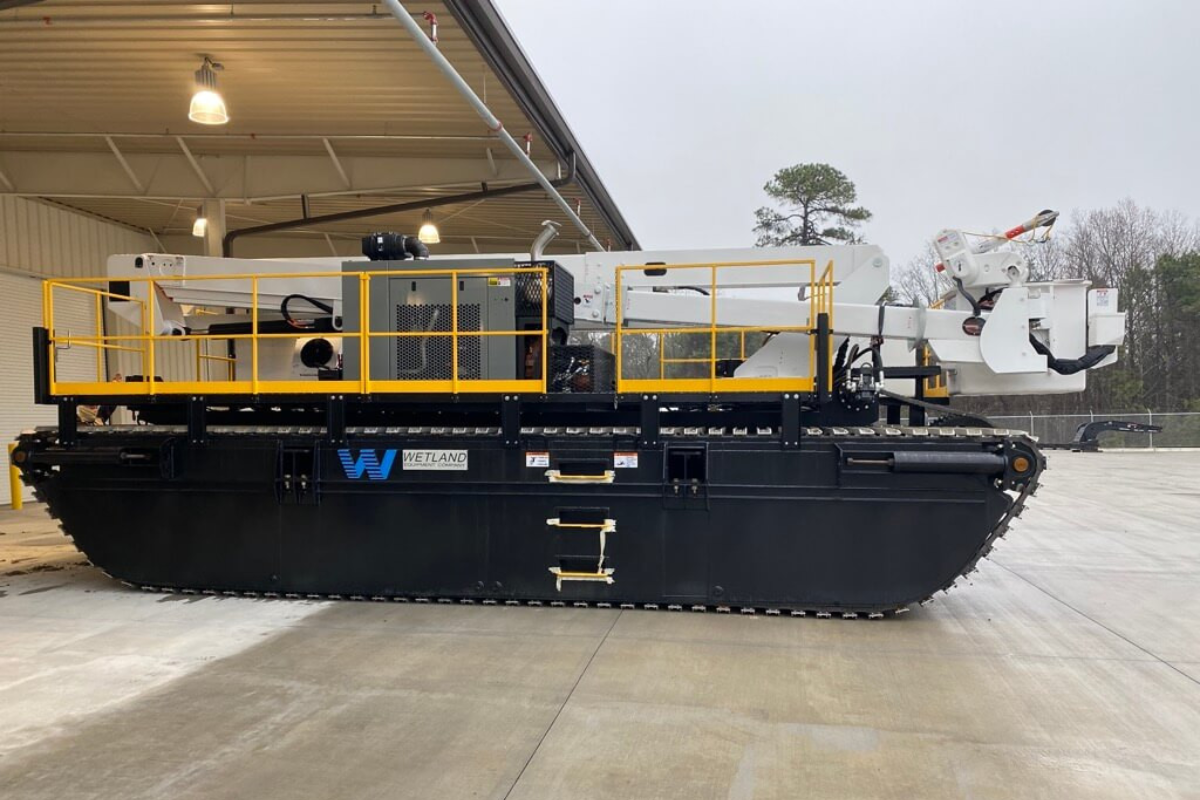
How Do You Operate Amphibious Carriers?
How Do You Operate Amphibious Carriers?
Amphibious carriers, in the context of construction, are heavy-duty vehicles designed with buoyant undercarriages that allow them to navigate both terrestrial and aquatic environments. These machines are essential for projects where traditional equipment cannot reach due to water barriers or unstable ground. However, operating an amphibious carrier can seem like a daunting responsibility. Wetland Equipment helps you explore the best practices for how to operate an amphibious carrier while familiarizing you with the equipment to help alleviate anxiety and worry.
Operating an Amphibious Carrier: Essential Steps
Driving an amphibious carrier is a multifaceted task that requires careful preparation and attention to detail to ensure safety and efficiency. Here are the essential steps for operating one of these versatile construction vehicles:
Step 1: Pre-Operation Inspection
Before starting the carrier, conduct a thorough pre-operation inspection. This includes checking the integrity of the pontoons for any signs of damage or leaks, ensuring that all hydraulic systems are functioning properly, and verifying that the engine levels (oil, coolant, fuel) are adequate. Inspect the tracks or wheels for any debris or damage that could impair mobility.
Step 2: Starting the Engine
Once the initial checks are complete, start the engine according to the manufacturer's instructions. This usually involves checking that the gear is in neutral, ensuring the parking brake is engaged, and then turning the ignition key or pressing the start button.
Step 3: Transitioning to Water
When moving from land to water, slowly approach the water at a controlled speed, making sure the entry point is free of obstacles and steep drops. Engage any necessary hydraulic adjustments to prepare the carrier for water entry, such as lowering the pontoons or adjusting the stability controls. As the carrier enters the water, monitor the buoyancy and balance, making adjustments as needed to stabilize the vehicle.
Step 4: Navigating in Water
While in water, navigation should be done cautiously. Keep a moderate and steady speed to maintain control and balance. Use the carrier’s propulsion system to maneuver. This might be track-based or involve separate water propulsion, depending on the model. Always be aware of water depth, currents, and underwater hazards.
Step 5: Transitioning Back to Land
Exiting the water requires attention to the approach angle and the surface gradient. Approach the shore at a slow, steady speed to ensure the tracks or wheels can gain traction. Once the carrier begins to exit the water, it may be necessary to adjust the hydraulic settings to optimize it for land travel. Ensure that the transition is smooth to prevent any undue stress on the vehicle’s systems.
Step 6: Post-Operation Maintenance
After operation, perform maintenance tasks. Clean the carrier thoroughly to remove any mud, debris, or water contaminants to prevent rust and corrosion. Conduct a post-operation check similar to the pre-operation inspection to ensure no new issues have arisen during use. Report and record any problems or irregularities experienced during operation for further inspection or repair.
Step 7: Secure the Vehicle
Finally, ensure the amphibious carrier is securely parked and shut down. Engage the parking brake and turn off the engine. Remove the key and secure the vehicle if it will be unattended. Cover the carrier if it will be stored outdoors to protect it from the elements.
By following these steps, operators can safely and effectively drive an amphibious carrier, maximizing its potential while minimizing risks in both aquatic and terrestrial environments. Whether for construction, dredging, or restoration, understanding these operational fundamentals is key to harnessing the full capabilities of this unique machinery.
Types of Amphibious Carriers
Amphibious Excavators: Modified with a floating undercarriage, these excavators are used for dredging, canal deepening, and marsh or swamp land clearing.
Amphibious Dump Trucks: These are specialized dump trucks capable of transporting materials such as soil, sand, and gravel over water and soft terrain.
Key Features and Capabilities
Buoyant Undercarriage: The undercarriages are typically equipped with pontoons filled with foam, ensuring buoyancy and stability in watery environments.
Adjustable Tracks: The tracks can be adjusted for different terrains, increasing their adaptability and making them ideal for various construction scenarios.
High Torque Drive Systems: These systems ensure that the carrier can move through tough, viscous environments like mud or swampy areas without getting stuck.
Environmental Suitability: Designed to have minimal impact on the environment, these carriers can work in sensitive ecosystems without causing significant disruption.
Understanding these specialized vehicles’ designs and capabilities provides a foundation for discussing how they are expertly operated in the field.
The Crew and Their Roles
Operating amphibious carriers can be done solo, but a successful project requires a team of skilled professionals who understand the unique challenges of working in both terrestrial and aquatic environments. Here’s an overview of the key roles and responsibilities involved:
Key Roles
Operator: The primary driver of the amphibious carrier, responsible for maneuvering the vehicle in diverse conditions. Operators must have specialized training to handle the complex controls and respond to the changing dynamics of land and water operation.
Mechanic: Due to the sophisticated and unique nature of amphibious equipment, a dedicated mechanic is crucial. They perform regular maintenance and address any mechanical issues that arise to ensure the vehicle operates efficiently and safely.
Site Supervisor: Oversees the operation from a project management perspective, ensuring that the use of the amphibious carrier aligns with the overall project goals, safety standards, and environmental regulations.
Environmental Specialist: Particularly in projects impacting sensitive ecosystems, an environmental specialist ensures compliance with environmental laws and regulations, assessing impacts and implementing mitigation strategies.
Training and Expertise
Operating an amphibious carrier requires more than standard heavy equipment training. Operators often undergo specific certification processes that include the safety protocols for both land and water navigation, learning how to minimize ecological impact during operations, and detailed knowledge of the mechanical and hydraulic systems unique to amphibious carriers.
Communication Systems
Effective communication is crucial, especially when visibility is low or in noisy environments. The use of radios and hand signals is common. Onboard GPS and project management software help in tracking the carrier’s position and monitoring progress relative to project milestones. Before and after each use, the carrier should be inspected for any signs of wear or damage, especially the pontoons and hydraulic systems. For urgent matters, crew members are trained in emergency procedures, including what to do in case of a pontoon breach, engine failure, or sudden weather changes. Operators must always be aware of the environment around them, avoiding operations that could lead to soil erosion or water contamination.
Deployment Operations
Amphibious carriers are deployed in a variety of construction and restoration projects, each requiring precise coordination and understanding of the task at hand. In waterlogged areas or shallow waters, amphibious excavators are used for dredging channels, excavating sediments, and removing debris. The material can be loaded directly onto amphibious dump trucks for transport.
Land reclamation carriers facilitate the movement and placement of large volumes of earth, sand, and other materials in efforts to reclaim land from bodies of water. In environmental restoration projects, such as wetland rehabilitation, amphibious carriers enable the delicate handling and transport of materials without excessively disturbing the existing terrain and vegetation.
Coordination and Execution
Detailed planning is crucial to align the capabilities of the amphibious carriers with the specific requirements of the project. This includes determining access points, assessing environmental impact, and scheduling operations to minimize disruption. Since amphibious carriers can access remote or difficult terrains, logistical planning must ensure that fuel, spare parts, and other supplies are available close to the operation sites. Using GPS and other tracking technologies, the movement and productivity of amphibious carriers are monitored to ensure they are performing as planned and to make adjustments in real-time if necessary.
Maintenance and Upkeep
When learning how to operate an amphibious carrier, maintaining a quality, safe vehicle is essential for their longevity and efficient operation. Given the harsh environments they often operate in, a robust maintenance regime is crucial. Operators perform daily inspections to check hydraulic systems, engine levels, pontoon integrity, and track functionality to catch and address any issues before they lead to major failures. After each deployment, amphibious carriers must be thoroughly cleaned to remove dirt, debris, and potential contaminants, particularly to prevent rust and corrosion on metal components exposed to water.
Challenges in Maintenance
The dual-environment use of amphibious carriers leads to accelerated wear and tear. Particular attention is given to pontoons and seals, which are crucial for buoyancy and water operations. Many parts of an amphibious carrier are specialized and can require significant lead times to replace, so keeping a stock of critical spare parts on-hand is a common practice. Technicians who maintain amphibious carriers need specialized training to understand the unique mechanical and hydraulic systems used in these vehicles. Ongoing training is crucial as new models and technologies emerge that may improve the efficiency or environmental footprint of these carriers.
Properly maintained, amphibious carriers are invaluable assets in construction, environmental restoration, and emergency response operations. They exemplify the intersection of engineering innovation and practical application, providing solutions where traditional machinery cannot operate.
Drive Easy with the Best Amphibious Carriers from Wetland Equipment
At Wetland Equipment, we understand the importance of reliability, efficiency, and environmental sensitivity in your operations. That's why we offer a range of top-tier amphibious carriers, each designed with the latest technology and robust features to ensure they meet the specific needs of your projects. Whether you're dredging, reclaiming land, or restoring ecosystems, our equipment is engineered to perform at the highest standards. Contact us today to learn more about our diverse offering of easy-to-operate amphibious carriers for sale.

